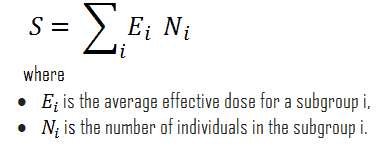man-sievert – person-rem – units of collective dose
The collective effective dose is defined as the sum of all individual effective doses in a group of people over the period or during the operation being considered due to ionizing radiation. The collective dose is given the symbol S. The unit of the collective effective dose is joule per kilogram (J.kg-1), and its special name is man sievert (man Sv). The person-rem is sometimes used as the non-SI unit in some regulatory systems. The collective dose can be obtained by the product of the average individual dose with the number of people in the group.
The collective effective dose is often used to estimate the total health effects of a process or accidental release involving ionizing radiation to an exposed population. On the other hand, it must be emphasized that all calculations that involve adding doses assume the Linear no-threshold model for health effects. But many organizations disagree with using the Linear no-threshold model to estimate risk from environmental and occupational low-level radiation exposure. There is a question of whether this number is meaningful at all.
According to the ICRP:
“The collective effective dose quantity is an instrument for optimization, for comparing radiological technologies and protection procedures, predominantly in the context of occupational exposure. A collective effective dose is not intended as a tool for epidemiological risk assessment, and it is inappropriate to use it in risk projections. The aggregation of very low individual doses over extended periods is inappropriate. In particular, the calculation of the number of cancer deaths based on collective effective doses from trivial individual doses should be avoided.”
Special Reference: ICRP, 2007. The 2007 Recommendations of the International Commission on Radiological Protection. ICRP Publication 103. Ann. ICRP 37 (2-4).
The collective effective dose is often used to compare occupational exposure data between nuclear power plants. From this point of view, the ISOE program provides a forum for radiological protection professionals from nuclear electricity utilities and national regulatory authorities worldwide to share dose reduction information and operational experience to optimize worker radiological protection at nuclear power plants. For example, the average annual collective dose in PWRs decreased from 2.01 man Sv in 1992 to 0.91 man Sv in 2001.
